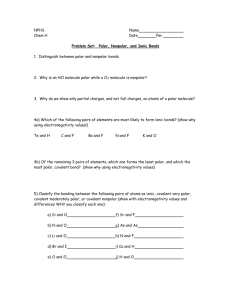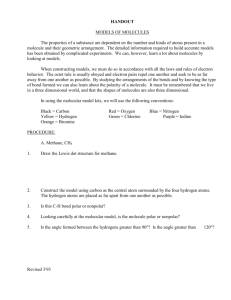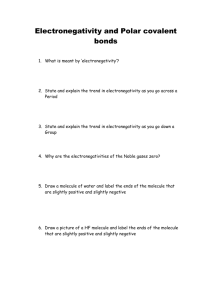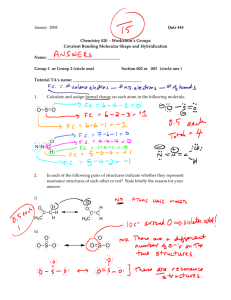Lewis Structures & Molecular Shapes Worksheet
advertisement
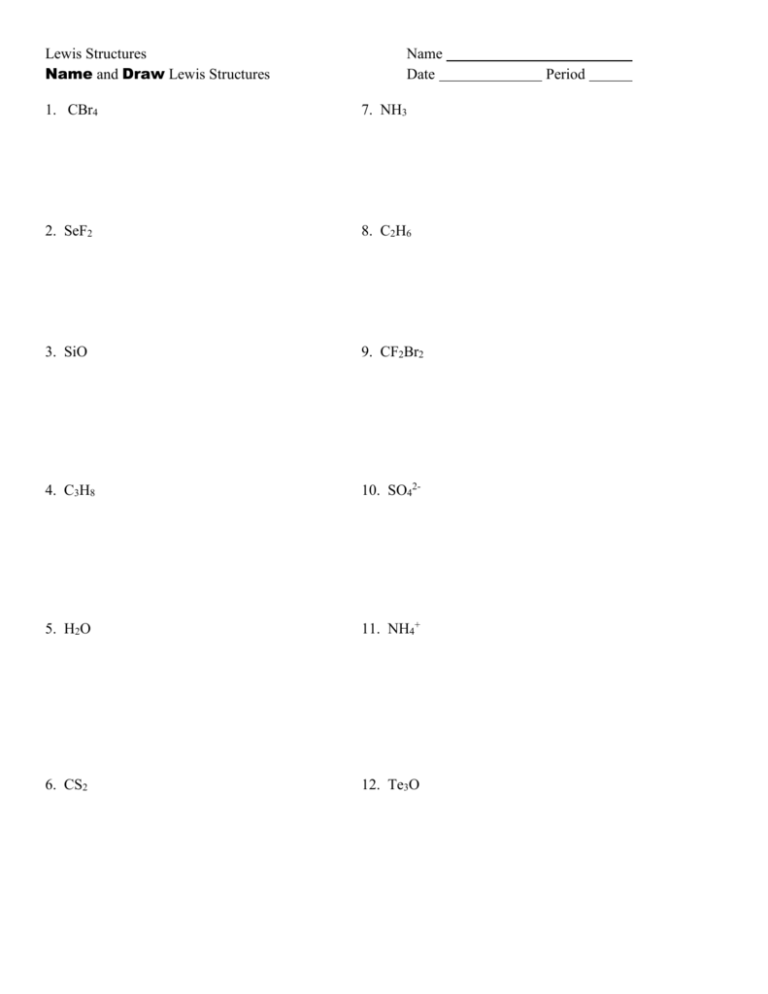
Lewis Structures Name and Draw Lewis Structures Name Date 1. CBr4 7. NH3 2. SeF2 8. C2H6 3. SiO 9. CF2Br2 4. C3H8 10. SO42- 5. H2O 11. NH4+ 6. CS2 12. Te3O Period The Name Is Bond – Chemical Bond Problem: Name_________________________ Data: Physical Characteristics of Three Unknown Substances Substance Appearance (Naked Relative Solubility Eye) Melting Point in Water A Electrical Conductivity Magnified Appearance B C Summing Up 1) How are the physical properties of the compounds A and B similar? How are they different? 2) Define the term electronegativity. 3) Find the table of electronegativities on page 263 of your text and answer the following: a) Subtract the electronegativity of Na from that of Cl. b) Subtract the electronegativity of C from that of H. c) Compare the differences in your answers to (a) and (b.) Based on the definition of electronegativity and the comparison you just made, what conclusions can you draw about the bond type that exists between Na and Cl verses the bond type between C and H. 3) Is the sample C more like compound A or B? Justify your answer with your data. Lewis Structures with Resonance: (Draw resonance structures where appropriate) SO32- CF3Cl NH4+ CO2 HCN HCO3- CH3CH2Cl NO3- C2H4 CO32- SO3 C2H2 Cl2 N2 CN- O3 CH3CH2OH SO2 Lewis Structures: Exceptions (Accelerated Only) ClO2- PCl5 BH3 SF6 NO2 I3- C2H4 NO NO2- NO+ BeCl2 BF3 Naming Covalent Compounds Write the formulas for the following covalent compounds: 1. antimony tribromide _______________ 2. hexaboron monosilicide ______________ 3. chlorine dioxide ___________________ 4. iodine pentafluoride _________________ 5. dinitrogen trioxide _________________ 6. ammonia __________________________ 7. phosphorus triiodide ______________ 8. dinitrogen tetraoxide ________________ Name the following covalent compounds: 9. P4S5 ______________________________ 10. O2 _________________________________ 11. SeF6 _______________________________ 12. Si2Br6 ______________________________ 13. SCl4 _______________________________ 14. CH4 ________________________________ 15. B2Si _______________________________ 16. NF3 ________________________________ Type Formula Name (ionic, covalent, element or ion?) 1 MgO 2 P4S5 3 Fe 4 SeF6 5 CsNO3 6 SCl4 7 SO42- 8 Fe3+ 9 NaC2H3O2 10 NF3 11 phosphorus tribromide 12 Copper (II) oxide 13 nitrate 14 phosphorus triiodide 15 iodine pentafluoride 16 Lead (IV) chloride 17 aluminum bicarbonate 18 dinitrogen tetraoxide Formula 1 NH4Cl 2 B2Si 3 C3 P 4 Si2O6 Type (ionic, covalent, element or ion?) Name 5 oxygen difluoride 6 dinitrogen trioxide 7 berylium hydroxide 8 hexaboron monosilicide 9 chloride 10 chlorine 11 potassium sulfate Name:________________________________ Date:_________________________________ Period:________________________________ Use your knowledge of Lewis structures and naming to complete the following table. Draw the molecule using the Molecule Shapes simulation from the PhET website to complete the molecular information: http://phet.colorado.edu/en/simulation/molecule-shapes. Name Formula SCl2 ICl3 O3 SO3 C2H4 NO3- TeCl4 OCS Lewis Structure Molecular Shape Name 3-D Molecular Drawing XeOF4 XeCl2F2 SCl3F3 C2H2Br2 -Win, Lose, or Draw Problem: How does VSEPR theory determine the shapes of molecules? How does shape affect the polarity of molecules? Procedure 1) Assign a color of Dot to represent each of the elements in the data table (C, O, H, S, and P). Some colors may represent more than one element 2) Draw the Lewis Structure for each of the molecules. 3) After you have done step two, use the appropriate dots and toothpicks to assemble a model of each molecule. For single bonds, one whole toothpick represents a pair of electrons. For double bonds, break a toothpick in half, each half represents one pair of electrons. For triple bonds, break a toothpick into thirds, each third represents a pair of electrons. Complete for all of the molecules in the table. (Do not disassemble models- in the end you will have 5 models.) Data Molecule Lewis Structure Name of Geometry Molecular Geometry SO3 PH3 H2O CO2 C2H2 H2 Cl2 N2 Win, Lose or Draw Name_______ Period___ Date_______ Summing Up 1) Contrast the Lewis structures of SO3 and PH3. 2) Contrast the geometries of SO3 and PH3. Why are they different? 3) In H2O, the oxygen (the central atom) has two hydrogens attached. In CO2, the carbon (the central atom) has two oxygen atoms attached. Explain why the geometries of H2O and CO2 are different. 4) Summarize the effect of the presence of unshared electrons on the shape of a molecule. 5) Contrast the length of single, double, and triple bonds. Which bond type is strongest? Why? Complete the table for each of the molecules. Lewis Structure PCl3 OF2 CO32- SiS2 PO43- HF Name__________________ Name of Shape Drawing of Shape The following molecules are polar. Draw the molecules and then, using their electronegativities, and include the δ+ and δ- ends. H2O (bent) HCl OF2 (bent) NH3 (trig. pyramidal) The following molecules are NOT polar. Please tell why each molecule is not polar. CCl4 O2 CO2 C2H6 Complete the chart: Part 1: Identify the Bond Type in each molecule as ionic or covalent. Part 2: For all covalent molecules, draw the molecular shape. If the molecule is polar, draw on the partial charges. Part 3: Classify all the covalent molecules as polar or nonpolar. Bond Type Polar or (ionic or covalent) If covalent, what shape? (with + or – if polar) Nonpolar? *if ionic, no shape or polarity CaI2 Polar/Nonpolar CBr4 Polar/Nonpolar CH4 Polar/Nonpolar Fe2O 3 Polar/Nonpolar H2 S Polar/Nonpolar NF3 Polar/Nonpolar
